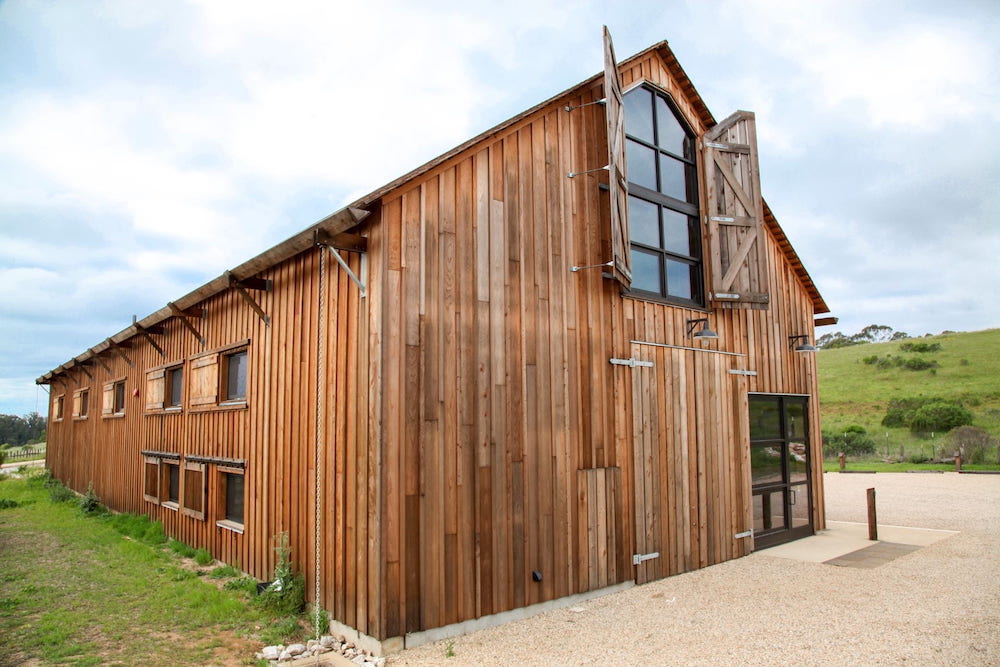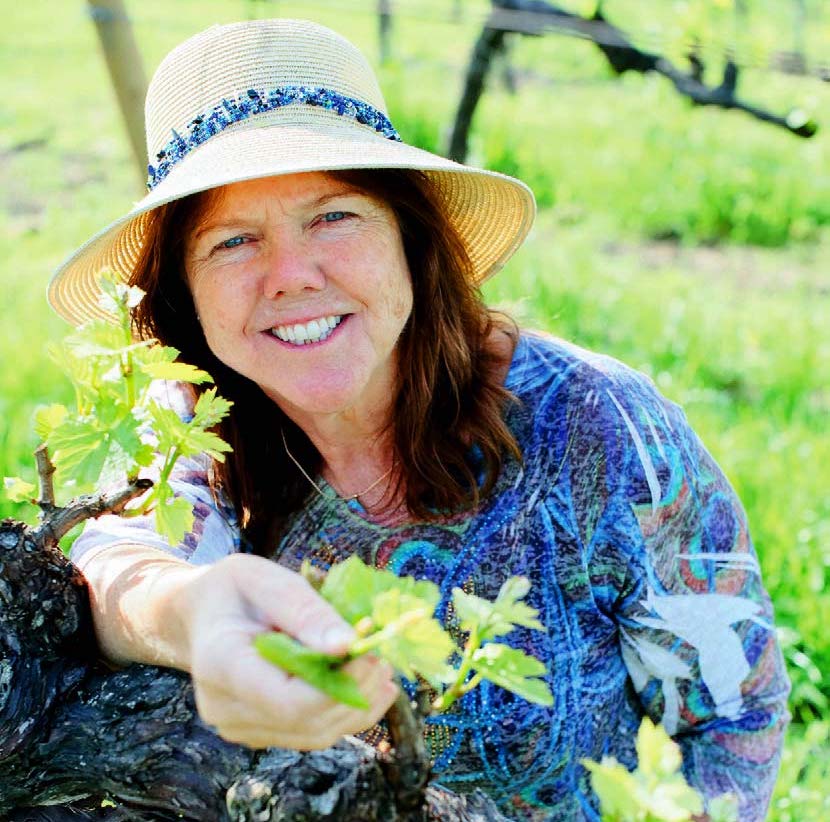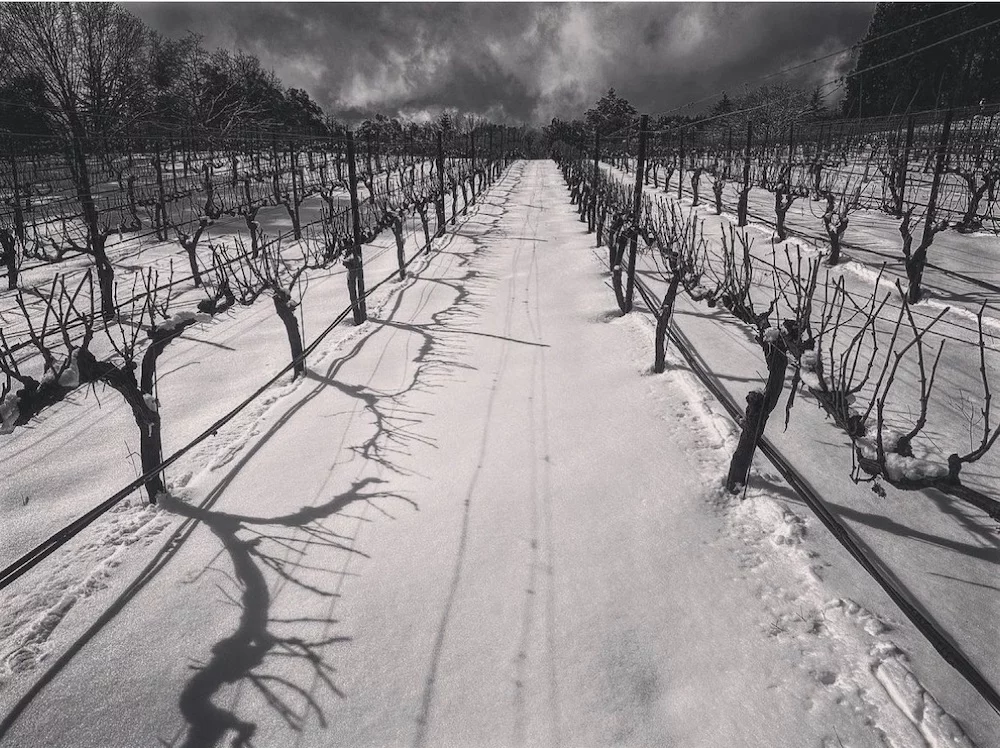
January 3, 2025 – Organic winegrowing is top of mind for most winemakers these days: consumers want to know what’s in their wine, and more importantly, what’s not. Consequently, many vineyard owners are shifting to organic practices.
Yet here in the Santa Cruz Mountains, fog and wind create enormous challenge, which is why many growers still skew towards conventional methods. Pretty much every year is a different story around these parts, and there are some truly amazing stories to be told.
At a presentation on organic viticulture held at UC Santa Cruz in December, we heard from four viticulture experts and from the audience—a mix of vineyard owners, farmers and wine industry folks. They were gathered to get some insights into the challenges and triumphs of organic farming, and to hear the results of a recent survey of Santa Cruz Mountains winegrowers conducted by Janet C. ”Jenny” Broome, Assistant Adjunct Professor at the UCSC Environmental Studies Department and Center for Agroecology.
The Center for Agroecology at UC Santa Cruz is planning to install an organic vineyard and potentially a winery on the campus near the Cowell Ranch Hay Barn. Potentially, such a plot could be utilized for applied research to support the development of efficient and sustainable organic viticulture techniques in coastal vineyards. Broome shared the online survey results, which indicated a good deal of interest in experimental research.
It also showed a noticeable shift towards a more diverse mix of grapes being planted in the region, which has long been a bastion of Chardonnay and Pinot Noir. Would it surprise you to know that among the top grapes of interest are Aligoté, Gamay, Sauvignon Blanc, Chenin Blanc, Nebbiolo and Grenache?
Most interesting, though, were the insights into dealing with the impacts of altitude, pests, soil health and canopy management.
We heard from four panelists, including:
- Steve and Pamela Storrs, Storrs Winery
- Prudy Foxx, Foxx Viticulture
- Ken Swegles, Skyline Vit consulting
- Kelly Mulville, Paicines Ranch, regenerative viticulture in San Benito County

When the Storrs got started in their wine careers in Santa Cruz County in 1988, there was a myth regarding Roundup,” Pamela told us. “They said it breaks down after two hours.” At the time, they could not afford land, but were one of the first to focus on Santa Cruz Mountains grapes. “Most everyone else was hauling grapes from Napa, Sonoma and Santa Barbara at the time.”
During Christmas week in 2001, they were the high bidders on an old apple orchard in Corralitos, adjacent to the Christie Vineyard from which they had been buying fruit. Their first order of business was to restore the soil health, for which they got help from the USDA’s Natural Resources Conservation Service. They also established owl boxes and perches for birds of prey.
For the Storrs, it was important to create wildlife corridors before planting vines, to mitigate deer being hit by passing traffic. “We also planted hedgerows as habitat for beneficials, and filter strips of natural grass and wildflowers for pollinators, and to filter rainwater and runoff so it is cleaner for salmon when it flows into the stream.” said Pamela. “Stuff is hard, so you do what makes you happy.”
Steve and Pamela are proponents of sheep as part of a regenerative ecosystem. They have 17 babydoll sheep now. “We trellised too low for sheep, so they can only be in the vineyard a short time before shoot growth. We really want them to eat weeds, but they would eat the leaves. They do eat pomace in the fall.” She cautions that you cannot have sheep without a guard dog, due to coyote and bobcats. They just got a puppy for good measure.
Viticulture expert, Prudy Foxx, had several important tips for organic viticulture, including the use of mineral oil (JMS stylet oil) instead of sulfur as an early season antifungal. “You have to be really proactive about powdery mildew in our coastal climate,” she said.

Foxx is an advocate of weather monitoring stations in the vineyard to measure mildew pressure and a big proponent of cover cropping to help break up and add nutrients to the soil. She also recommended a multi-purpose tool by Clemens for weeding and cleaning around the vines. “We need more specialized equipment for small coastal vineyards, and we need to train workers on how to use them.”
Viticulturist Ken Swegles has experience farming over 45 extreme sites in the Santa Cruz Mountains along with business partner, Cole Thomas. Swegles and his wife Abbey Chrystal live on one of the vineyards he tends. Located at 2500 feet, Ascona Vineyard on Skyline Boulevard got enough snow in the winter of 2023 that they could snowboard down the vine rows.

At the former Christmas tree farm they use every trick that works, from learning vine care from master pruners in Italy, to using chickens, ducks and geese in the vineyards as pest abatement. Their massive Pyrenees-Anatolian shepherd mix, Nala, guards them, but there’s not much you can get past a protective goose. “Not only do they eat snails, but they scare away foxes. They also eat suckers on the vines.”
Although he would not consider himself a devotee of Rudolf Steiner’s bio-dynamic farming techniques, he does embrace the idea of close-loop farming systems.
“We’re trying to keep everything in house here,” Swegles said. “We are developing our own bacterial solutions for early season bud break protection. We are trying to minimize outside influence. We are experimenting with horsetail and yarrow and nettle.”
They are shoot-thinning as soon as they reach 4 to 6”, to push for fruit quality, not quantity. “We might get 8 to 10 grapes on a bunch instead of 14,” he said.
Formerly a “no-till” advocate, Swegles has come to appreciate the benefits of discing to aerate soil and disturb gophers, who will eat vines at any age. High altitude sites experience incredible solar pressure, measured by a pyranometer, and heat buildup, to the point where Swegles won’t use sulfur if the canopy temperature exceeds 80 degrees, to prevent leafburn.
The final speaker told the story of Paicines Ranch, a massive experiment in regenerative agriculture that encompasses 7,800 acres of rangeland, where cattle and turkey roam, and as it turns out, some exciting developments have taken place regarding grape trellising.
Ranch Manager Kelly Mulville says he wanted to be able to graze sheep in the vineyard year-round, so he developed a new VSP system that is v-shaped and puts the shoots above the height of the sheep. He says he is the only one using this type of trellis, which he has tried to patent.

“We use about 1,400 sheep for 12 hours to do suckering for us,” says Mulville. “The saliva and urine from the sheep are actually beneficial to the plants. Vines do not discourage grazing, otherwise they would produce thorns.”
The ecosystem—abundant with all those sheep, plus, turkey and chickens—is thriving, he says. “When we started installing the vineyard, we had 11 species of plants,” says Mulville. “Now we have over 100.”
Dr. Broome ended the session by revealing they had received 33 responses on 75 surveys sent out, and by far the majority of Santa Cruz Mountains vineyards considered themselves mostly organic or sustainable. By far, most are 1 to 5 acres, with some up to 10 and few up to 30. Naturally, most are Chardonnay and Pinot Noir, with a good deal of Cabernet Sauvignon, a little Cabernet Franc and a smattering of Syrah.
Most indicated a preference for more research in pest and disease management, water savings/retention and labor maximization. Some specifically asked about ultraviolet light carrying drones to address powdery mildew. Others expressed an interest in equipment leasing.
The next chapter of vineyard agriculture may well be written at UC Santa Cruz. One thing is for sure: it is evolving with climate change and human ingenuity, as well as the livestock and fowl that make up Old MacDonald’s Farm.
About the author
Laura Ness is a longtime wine journalist, columnist and judge who contributes regularly to Edible Monterey Bay, Spirited, WineOh.Tv, Los Gatos Magazine and Wine Industry Network, and a variety of consumer publications. Her passion is telling stories about the intriguing characters who inhabit the fascinating world of wine and food.
- Laura Nesshttps://www.ediblemontereybay.com/author/lness/
- Laura Nesshttps://www.ediblemontereybay.com/author/lness/
- Laura Nesshttps://www.ediblemontereybay.com/author/lness/
- Laura Nesshttps://www.ediblemontereybay.com/author/lness/


